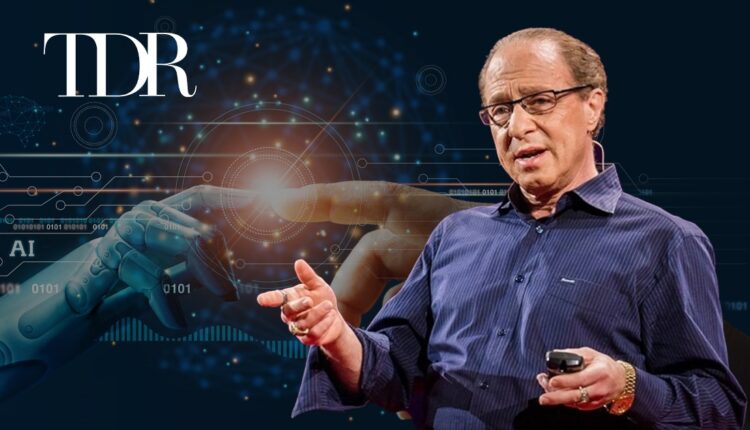
Ray Kurzweil Predicts the AI Future by 2045
The TDR Four Key Takeaways regarding Ray Kurzweil Predicts the AI Future by 2045
- What happened: Ray Kurzweil announced that his book, “The Singularity is Nearer,” explores the current progress and future implications of AI and predicts the arrival of the singularity by 2045.
- History: Kurzweil, a renowned futurist, originally published “The Singularity is Near” in 2005, predicting a technological singularity where AI surpasses human intelligence.
- Why it matters: The predictions highlight significant advancements in AI, potentially transforming society and raising ethical, economic, and technological questions.
- What is next: Kurzweil emphasizes the need for careful management of AI development to ensure its benefits are maximized while minimizing potential risks.
Renowned futurist Ray Kurzweil has once again stirred the technological waters with his latest book, “The Singularity Is Nearer.” Building on the foundation he laid in his 2005 publication “The Singularity Is Near,” Kurzweil explores the current progress and future implications of artificial intelligence (AI), boldly predicting the arrival of the singularity by 2045. This anticipated period, where AI surpasses human intelligence, carries profound potential to transform society, presenting both unprecedented opportunities and significant challenges.
Kurzweil’s optimism about technological advancements is palpable throughout his new book. He reiterates his belief that “information technologies like computing get exponentially cheaper because each advance makes it easier to design the next stage of their own evolution.” This exponential growth, according to Kurzweil, is already evident as “one dollar now buys around 600 trillion times as much computing power as it did when the GPS was developed.” Such rapid advancements in computing power set the stage for revolutionary changes in various fields, from medicine to manufacturing.
A central thesis of Kurzweil’s work is that “history is nothing but the evolution of information processing.” He categorizes this evolution into “six epochs, or stages, from the beginning of our universe.” Kurzweil envisions that in the sixth and final stage, “our intelligence spreads throughout the universe, turning ordinary matter into computronium, which is matter organized at the ultimate density of computation.” While this concept may seem abstract, it underscores his belief in the boundless potential of merging human intelligence with AI.
As we approach the fifth epoch, Kurzweil predicts that “we will merge with AI and augment ourselves with millions of times the computational power that our biology gave us.” This merging, he suggests, will lead to dramatic improvements in quality of life, with technologies such as 3D printers providing sufficient clothing and housing for everyone, and AI pioneering new medical treatments. “As AI unlocks unprecedented material abundance across countless areas,” Kurzweil writes, “the struggle for physical survival will fade into history.”
However, Kurzweil is not blind to the challenges that lie ahead. He acknowledges that the transition to a post-singularity world will involve significant upheaval. “Once our brains are backed up on a more advanced digital substrate, our self-modification powers can be fully realized,” he states, suggesting that such profound changes in human capability will require careful management. Kurzweil argues that AI should be viewed not as a competitor but as “an extension of ourselves.”
Despite his optimism, Ray Kurzweil recognizes the potential for disruptions. He speculates that “as nanotechnology takes off, we will be able to produce an optimized body at will: we’ll be able to run much faster and longer, swim and breathe under the ocean like fish, and even give ourselves working wings if we want them.” Yet, he admits that smart government policies are necessary to “ease the transition and ensure that prosperity is broadly shared.”
Kurzweil’s predictions are not without their critics. Many question whether his visions are overly utopian, particularly regarding the equitable distribution of technological benefits. While he claims, “history gives us reason for profound optimism,” skeptics point to the current inequalities in access to food, healthcare, and other resources.
In contemplating the future, Kurzweil touches on the intersection of technology and the arts. He believes that virtual reality will allow for deeper artistic expression, suggesting that “actors can now convey what their character is thinking only through their words and external physical expressions,” but in virtual reality, we will “have art that puts a character’s raw, disorganized, nonverbal thoughts — in all their inexpressible beauty and complexity — directly into our brains.”
Kurzweil’s vision extends to everyday experiences, predicting that in the “digital universe,” simulated versions of products will suffice, such as “a sensory-rich virtual beach vacation for the whole family.” He concludes that “computers will be able to simulate human brains in all the ways we might care about,” although many might argue that digital simulations can never fully replicate the richness of physical experiences.
Kurzweil’s insights highlight the need for a balanced approach to AI development, urging us to harness technology responsibly for the greater good of humanity. The journey to 2045 will be complex but promises a transformative era in human history with thoughtful management.



